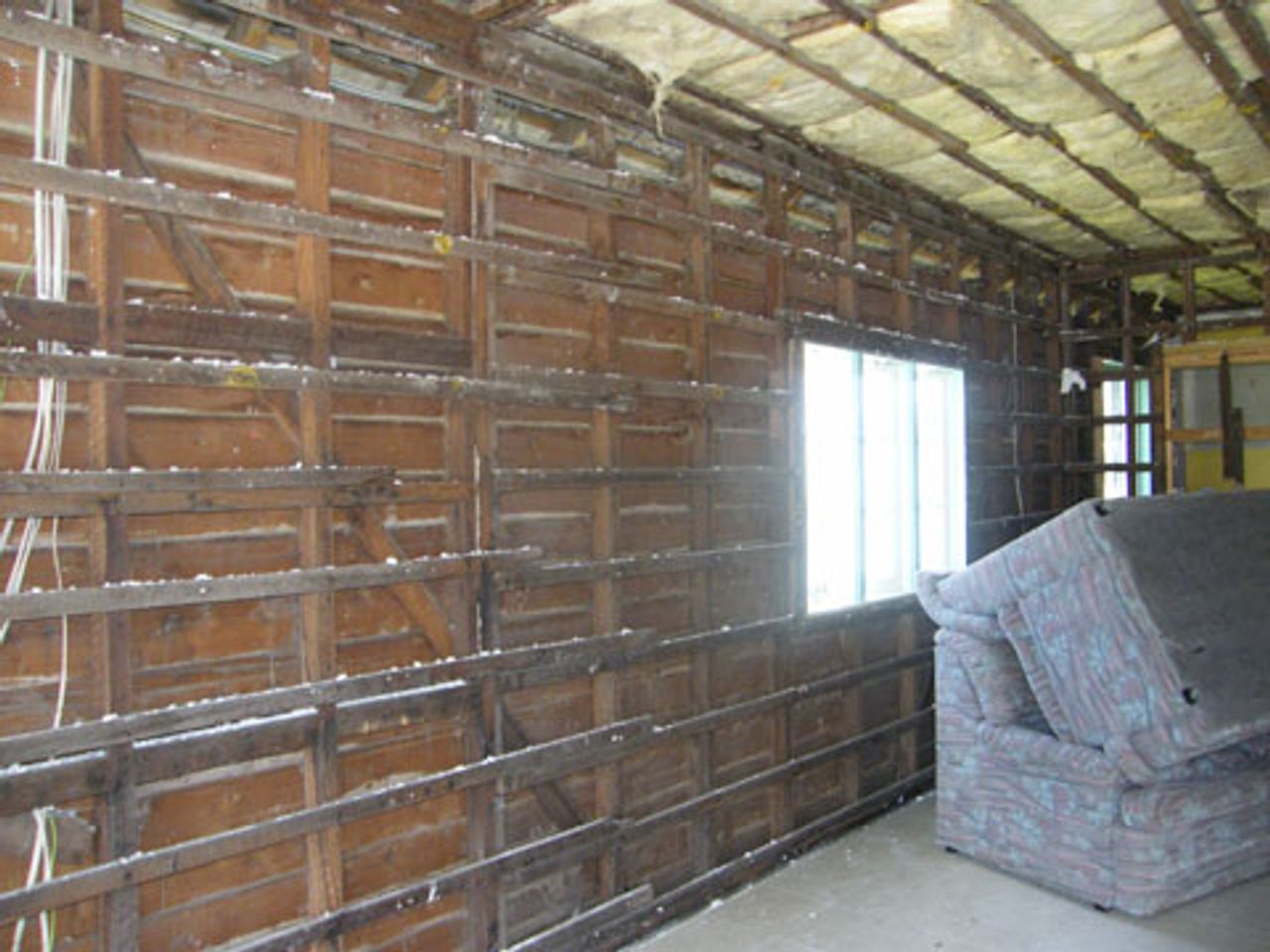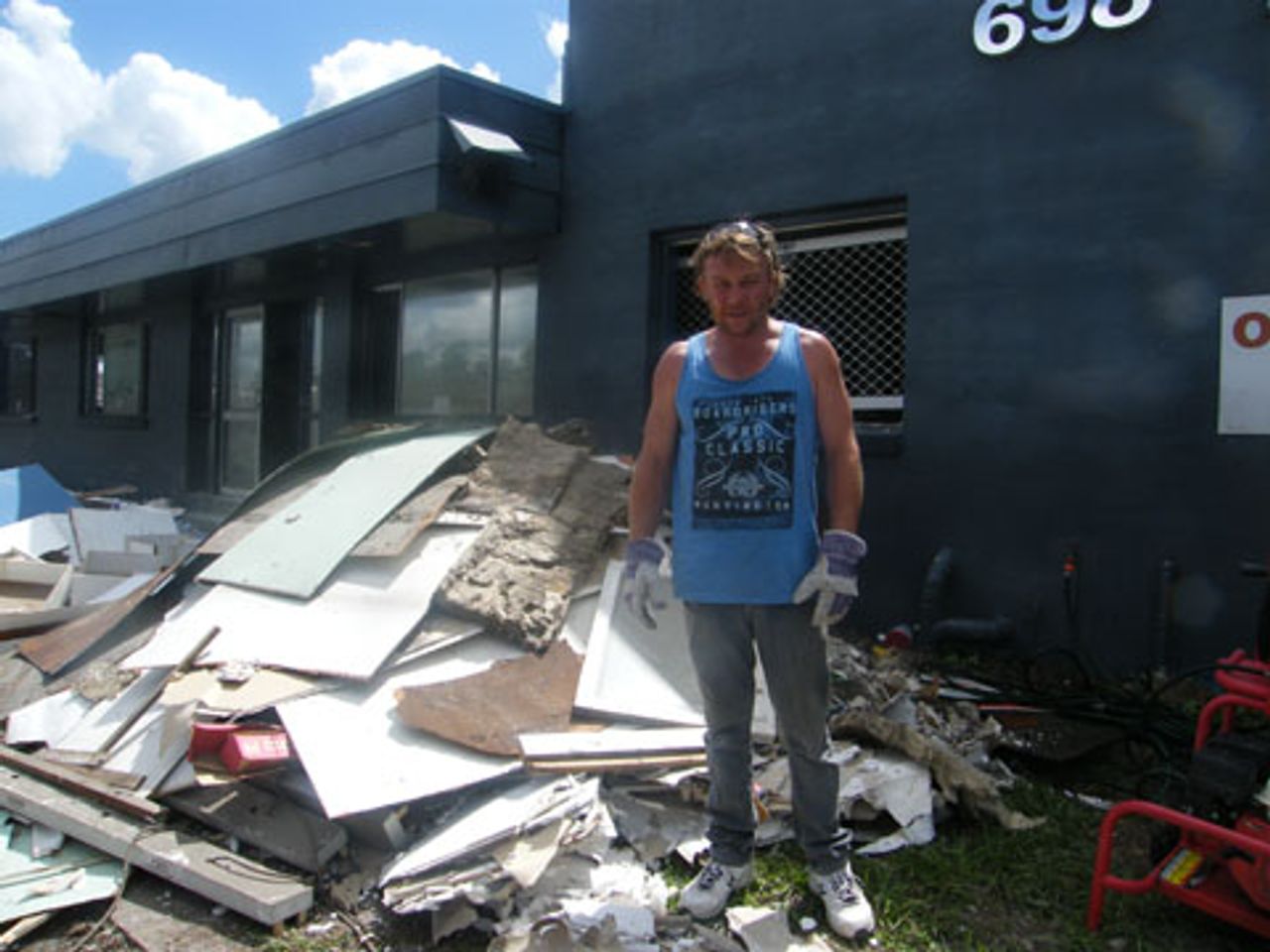It is now three weeks since large parts of Brisbane, the Queensland state capital, were inundated by the worst floods in the city since 1974. As far as the corporate media is concerned, the story, or at least the disaster’s impact on ordinary people, has gone cold. The federal and state governments have essentially declared their “relief” efforts successful.
A visit by World Socialist Web Site reporters to the Brisbane southern suburbs of Rocklea, Archerfield, Yeronga and Fairfield on Friday revealed that this is far from the case.
 Damaged Archerfield home
Damaged Archerfield homeDriving around the area, it initially appeared that many streets had escaped the floods. There were no mountainous piles of debris, flattened homes or construction work underway—common sights in those areas most severely devastated, such as the small agricultural town of Grantham, or Goodna, a working-class suburb of Ipswich.
On closer inspection, however, signs of the impact of the flood became apparent. There were dirty water marks high on the walls of houses and businesses, and everywhere the caked mud was interspersed with particles of plasterboard. Other pieces of debris and small personal items missed in the clean-up lay on footpaths, nature strips and in gardens. Residents immediately began explaining how the disaster had left deep social scars, economic stress and psychological trauma.
 Jennifer Mann
Jennifer MannJennifer Mann, a housewife from Archerfield and the mother of two young children, said numbers of houses in the street were unoccupied because they had been inundated and were uninhabitable. Mann was spared a similar fate because she lives in an elevated home. Downstairs, everything was lost or irreparably damaged, including engine parts, a washing machine and two cars her boyfriend had been repairing.
Mann said she had not received an official flood warning. Nor had radio and television news programs mentioned the dangers facing residents the night before Archerfield was hit. The next morning she had awoken to a strange sound underneath the house, went outside and saw fast rising ankle-deep floodwater.
In the aftermath, she and other Rocklea Street residents face serious financial hardship. Mann was only given $1,800 from Centrelink, despite explaining her financial difficulties. She had to spend the money on pressing debts. None of the residents who spoke to WSWS reporters had home contents insurance.
Mann noted the disparity between the response of ordinary people who had assisted her and thousands of other residents through the city, and the treatment she had received at the hands of the government. Other residents made the same observation and said the absence of official warnings had led to fear and chaos.
No one had known how long they had before flood waters would inundate their homes and so residents had rushed to salvage what they could before evacuating. This had led to dangerous traffic jams and panic.
 Furniture stripped bare by toxic flood water
Furniture stripped bare by toxic flood waterResidents also had to contend with the fact that the water—described as an “inland lake” by the local media—was laced with oil and other toxic substances from local workshops and factories.
Matt McInerney, a 21-year-old student, showed us polished furniture that had been stripped to the raw wood by the toxic waters. Aerial photos of Archerfield during the floods clearly show slicks of oil and thick sludge. Many businesses were also hard hit by the oil- and chemical-laced inundation.
McInerney said the local council planned to hold a community meeting—not to discuss what should be done for flood-affected residents or why they were not warned about the deluge—but to discuss increasing flights at the nearby Archerfield aerodrome.
Rocklea, 12 kilometres from Brisbane’s CDB, is a major industrial and transport hub and home to the city’s largest fruit, vegetable and flower market. The market was shut down for almost a week, affecting the distribution of produce throughout the state and Australia’s east coast. Millions of dollars in fruit and vegetables were destroyed. A number of beef cattle drowned when they were washed down from a nearby livestock yard.
Driving down one of Rocklea’s main roads, we noticed workers outside a demolition business hosing down doors, window frames and furniture. Mark Christensen, who owns the business, explained that his factory had been submerged in four metres of water, coating his equipment with mud and oil. Attempts by his employees to clean the equipment seemed to produce little result.
 Mark Christensen
Mark ChristensenChristensen, like other Archerfield residents, was given no warning of the impending disaster. He was not told to evacuate his business, which had opened just nine weeks earlier. The company faces losses of $50,000.
“This is much worse than starting from scratch again,” he said. “Everything is damaged and devalued. Just sorting through the stock takes a lot of time to salvage what you can.” He said that none of the 15 businesses in the industrial strip was covered by insurance.
Many residents said they had not been told that their homes were on land inundated in the major 1974 flood. Christensen explained that one woman he knew had planned to buy a nearby house, demolish it and rebuild. She had asked him to check whether it had been affected by the 1974 floods.
“I could see it had mud caked in the underneath beams, so she didn’t buy it,” he said. “If she had, it would have been hit by this flood and she would probably have lost everything.”
Later in the day we met a builder, Neil Conwell, who was repairing one of his rental properties. He said that because the area was officially defined as a flood-prone area by his insurance company, he would receive no compensation for his losses, estimated at $50,000. The rental property was opposite six other homes that were completely destroyed.
Conwell explained that the rising Brisbane River had caused the storm water drainage to backup and flood the area, which is over two kilometres from the river. He said that after construction of the Wivenhoe Dam in the 1980s, council regulations had allowed developers to build homes in what was defined as the “one in one hundred year level”—far lower than the 1974 floods.
Conwell said that 14 houses that he had built in the suburb of Indooroopilly under these council regulations had been inundated by the recent floods.
 Peter Poulsen
Peter PoulsenPeter Poulsen, a 59-year-old builder living in the better-off riverside suburb of Yeronga, explained that water had swept under his elevated home and that building materials and power tools had been lost or damaged behind repair.
Poulsen estimated the damage at $50,000 but had just realised that his insurance would not cover the total amount. He had applied for a $1,000-$2,000 government grant two weeks ago but had received no reply. Poulsen said that more than 20 of the 30 houses in his street had been severely affected, with many now unoccupied.
Like most people we spoke to, Poulsen had thought that the Wivenhoe Dam would prevent major flooding. The long-time south Brisbane resident said he had never seen the suburb so badly flooded. “I think development has a lot to do with it,” he said.
Poulsen explained that urban development on the Brisbane River flood plain, and the construction of the Rocklea markets, car parks and higher road levels, had blocked natural runoffs and channelled the torrents of water into the adjoining suburbs.
He also told WSWS reporters his concerns about the psychological impact of the disaster and recalled the serious rise in suicides after the 1974 floods. He predicted that similar tragedies would increase following the latest catastrophe.
“People are unable to re-establish their homes. Life becomes daunting for them and they become completely overwhelmed,” he said. “I saw this in 1974. People need assistance for a long time after, but it’s not there.”
